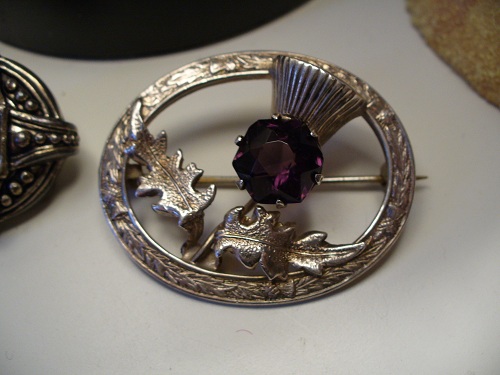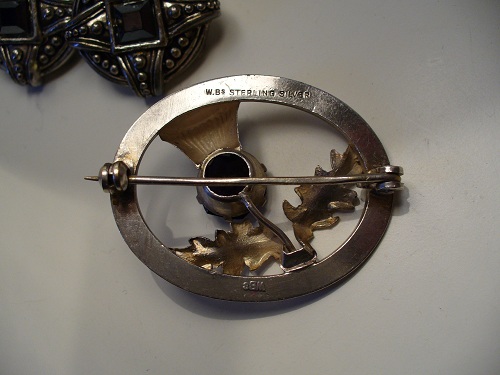This is supposed to be a sterling silver piece by the ward brothers however I have never seen the markings on this piece in any registered hallmark for this company, nor do I see any mark to denote the purity of the silver. If this is real can anyone tell me why and what makes it so. Also it does look like it was just molded with indications of machine marks on the one edge. Not to mention the pattern isn’t found in any of the ward brothers thistle brooch pieces I have seen before. If you can tell me what makes this real or fake and if it’s real what the purity/value might be I would be very grateful


My feeling is that this is most likely what it purports to be. There is no hallmark because, presumably, it is not heavy enough to require hallmarking and the consequent expense of formal assay. The company themselves (and I have no reason to doubt that it is Ward Bros) are warranting that the brooch is sterling silver. To be described as sterling it must be at least 925 quality. From your spelling of “molded” I deduce that you are probably American so the alternative explanation is that the brooch was specifically made for the American market where hallmarking is not a legal requirement.
what i meant by molded was that so many people make there own costume jewelry and fakes are very big in any antique or collectible market that its possible someone made a mold of this particular piece and fashioned their own pin using a lesser metal like copper and finished it with silver plating to sell for the price of a real ward bros item. I know they didnt hallmark the items under 7 grams but i see the raised WBs on the bottom and it poised questions for me because i never saw this before on their work. just a rectangle and diamond with the WBs inside. it almost looks like that WBs on this pin is extra silver tacked on. im not an expert but it pays to ask questions. also the style of thistle and amethyst stone pins they made i never saw this particular pattern. is it possible to date this or identify the pattern as one of their works from Edinburgh. i know they worked in two different places in Scotland in the 19th century maybe its from the other place.
I am not an expert - or anything approaching one, but I would have put this at second half of the 20th century.
Thank you that helps me quite a bit. Do you think it’s the entire pin that is silver or is the fastening and actual pin that holds it on the clothes usually a different metal? Also is the gem glass or genuine amethyst and is there a way to tell or should I save that for a different forum 
The pin and mount are often a different, more durable, metal than silver and the gem is most likely glass, but to be sure I would suggest that you have an expert look at it. It is always very difficult to make judgements from pictures alone.
Real silver
This is for Mizpah, also a name brand used by the Ward Brothers and Quarrier Ward. Not having the full silver hall marks because of its silver weight being under that to qualify for a full hall mark.
Real silver made by the company who’s designs have been taken over by Miracle jewellery. This brooch can be found also in chrome and gold plate versions.
Made over a long period of time from early twentieth century to the 1990s. Plenty of these are around and are very collectible. As other silver similar pieces marked the same, eg cameo brooches, Scottish grouse foot brooches, etc
Hardly likely to be faked as mass produced. The WBs mark is very common especially on their costume jewellery. Commonly found in the UK as well as the US and Europe.
Price at Oct 2012 £20 to £30 depending on the different stones used and vintage quality. More likely to be glass amethyst rather than a gemstone for their lower value range.
Mizpah pieces have a two hearts and an arrow through and may/may not be signed Mizpah on the back. Not to be confused with the sentimental jewellery also called Mizpah.
Hope this answers any of the questions raised.